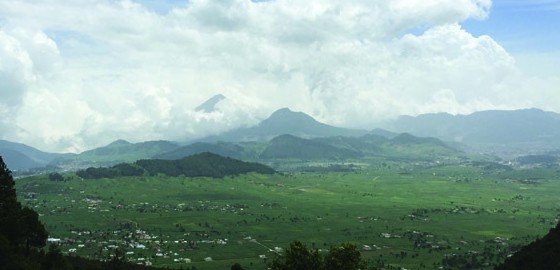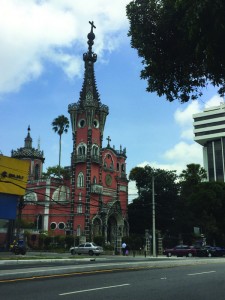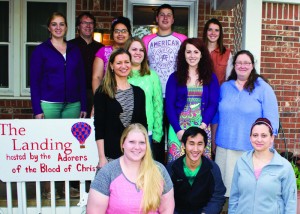
Guatemala and El Salvador trip offers lessons in language, history, life
During the beatification ceremony of Archbishop Oscar Romero, on May 23, 2015 in the city of San Salvador, a rainbow emerged – encircling the sun that shone on the 250,000 people who had gathered for the event. The phenomenon drew ahhs, gasps of wonder and a burst of camera clicks from the crowd in El Salvador del Mundo Square.
“We all saw this as a sign of beauty,” said Newman University student Victor Phan, who was at the event. “The beatification was blessed by the people – and the environment.”
The rainbow was the first of what would become many sights and experiences that inspired awe and increased awareness for Phan, and the eight other Newman students, three faculty members and one alumna who traveled to Central America for the Summer 2015 “Guatemala Study and Serve Program.”
“I learned a lot about myself and the people of the world, said Phan, a junior with a biochemistry (pre-med) major and a Spanish minor. “It is one thing to read about the struggles of another country, but it is amazing to see.”
‘A kind of love’
 Phan and the other participants of the eight-week program are the most recent Newman group to learn first-hand about other countries and people through the Study and Serve program. Since launching the program in 2007, Assistant Professor of Spanish Sonja Bontrager has guided groups through Guatemala nearly every summer to study the history, languages and cultures of the country, and work with individuals and organizations serving those living in great poverty.
Phan and the other participants of the eight-week program are the most recent Newman group to learn first-hand about other countries and people through the Study and Serve program. Since launching the program in 2007, Assistant Professor of Spanish Sonja Bontrager has guided groups through Guatemala nearly every summer to study the history, languages and cultures of the country, and work with individuals and organizations serving those living in great poverty.
Each year, groups spend a day getting acclimated to Guatemala by visiting such sites as the National Cathedral, markets and museums. Students then live for a week with host families in La Labor, a small community on the outskirts of Guatemala City, where they experience everyday life first-hand. At the same time, students take part in an intensive week of service in conjunction with Dani Brought, ASC, and Kris Schrader, ASC, who have lived many years in the area.
 Brought, who founded the Sangre de Cristo Health Care Project 20 years ago, created the service week for the Newman group. She designs opportunities for the students to work alongside the Health Care Project staff building latrines and stoves, teaching children healthy habits, planting trees in a reforestation project, and collaborating on children’s dental health education campaigns.
Brought, who founded the Sangre de Cristo Health Care Project 20 years ago, created the service week for the Newman group. She designs opportunities for the students to work alongside the Health Care Project staff building latrines and stoves, teaching children healthy habits, planting trees in a reforestation project, and collaborating on children’s dental health education campaigns.
Participants also meet local students and help them with their English at the secondary school, Instituto Maria de Mattias, which was founded 27 years ago by Schrader, and learn more the school’s efforts to improve the quality of life in the area.

“The service week is foundational and very important, and we’re very grateful to the sisters for providing this opportunity for us.” Bontrager said. “We make a personal connection to the ASCs, their mission, and with the host families, and we all develop a perspective that helps us for the duration of the summer program.”
Following the week with the ASC, the group spends five weeks in the western mountains studying Spanish, history and culture in and around Guatemala’s second largest city, Quetzaltenango.
Bontrager said that beginning with the service week, the group practices a “technology fast,” where they disconnect from the Internet and text messaging. Students can still take pictures, but most turn in their phones so they can give their full attention to the experience and more fully engage in their host community.
Judging by students’ remarks, the fast seems to have the desired effect.
“As we ‘served’ the people by teaching the kids proper dental care, painting the Institute, or building the stoves for the family, I saw the pure joy and love of the people,” said Becca Kopper, a sophomore at Newman studying psychology and criminal justice. “The kids were excited to meet new people as well as receive a gift as simple as a toothbrush.”
“It opened my eyes to the health disparities of the world and will forever influence my decision of what kind of physician I will ultimately become,” said Nicole Shaw, a May 2015 graduate who is now at the University of Kansas School of Medicine. “I experienced a kind of love, from complete strangers, during my time in Guatemala that I have never seen in my entire life in the United States.”
Politics and history
For this year’s Study and Serve trip, Bontrager decided to add a short foray into El Salvador. After locking in the dates, she learned that the days she selected coincided with Romero’s beatification. Bontrager said she was excited that this year’s trip offered students the opportunity to view the ceremony and public veneration of Romero.
“For years, I have wanted to explore adding a visit to El Salvador and to the sites that honor the work and sacrifice of Archbishop Romero,” Bontrager said. “Thanks to some funding from the Gerber Institute [of Catholic Studies at Newman University], it became possible.”
 To prepare for the trip, students read, studied and discussed the politics and history of Guatemala, El Salvador and other Central American countries. Students soon learned that for residents of those countries ‑ especially the poor and the Catholic ‑ politics and history are often brutal.
To prepare for the trip, students read, studied and discussed the politics and history of Guatemala, El Salvador and other Central American countries. Students soon learned that for residents of those countries ‑ especially the poor and the Catholic ‑ politics and history are often brutal.
Beginning in the early 1960s, Guatemala endured a war between the authoritarian military government and leftist guerillas that raged for 36 years, claimed the lives of an estimated 200,000 people, and created a million refugees. Among those killed was Father Stanley Rother, a missionary from Oklahoma who served the Tzutuhil Maya in Santiago Atitlan, Guatemala, for 13 years. He became a marked man by the Guatemalan Army for giving aid to residents after the army imposed a reign of terror that included random kidnapping, torture and the killing of innocent civilians. In 1981, Rother was murdered by three masked men in the rectory of his church.
Another prominent clergyman, Bishop Juan Gerardi of Guatemala, presented a multi-volume report in 1998 entitled Guatemala: Never Again! The Official Report of the Human Rights Office by the Archdiocese of Guatemala. This Recovery of Historical Memory report, overseen by Gerardi, outlined atrocities committed by the military during the civil war, and documented tens of thousands of deaths, forced disappearances and human rights abuses. A full 80 percent of the victims were indigenous. Two days after its publication, Gerardi was bludgeoned to death in his garage by members of the Guatemalan Army.
 In El Salvador, Archbishop Romero was a victim of a civil war that developed when leftist revolutionaries rose up against the repressive U.S.-backed Salvadoran army. For decades, the army used death squads and torture to maintain power. About 80,000 people died and 12,000 disappeared during the 1980-1992 civil war.
In El Salvador, Archbishop Romero was a victim of a civil war that developed when leftist revolutionaries rose up against the repressive U.S.-backed Salvadoran army. For decades, the army used death squads and torture to maintain power. About 80,000 people died and 12,000 disappeared during the 1980-1992 civil war.
Romero became a regional hero for speaking out against violence and defending the poor. He was assassinated in 1980 soon after calling on the Salvadoran military to refuse orders from officials if the orders did not follow the teachings of God and the Catholic Church. Romero was shot in a San Salvador chapel as he celebrated Mass. He was the first Catholic bishop killed in a church since Thomas Becket was murdered in Canterbury, in 1170.
Bontrager noted that the effects of these events on local populations were not only physical.
“People who live in areas of war have a different take on the gospel,” she said. “They know that many who stand with the poor and disenfranchised against the powers that be may pay with their lives, as Jesus did. Christianity and faith take on a more sobering meaning there.”
In the days leading up to Romero’s beatification, Bontrager and the group visited several locations related to Romero’s life that are now monuments, including the small, simple house behind the Hospital La Davina Providencia where Romero lived, and the cathedral where his remains are buried. They also went to war memorials and the Universidad Centroamericana, where several Jesuit priests, their housekeeper and her daughter were murdered during the conflict.
On the day of the beatification, the group was guided by the daughter of the mayor of San Salvador at the time of Romero’s assassination.
“She is also the niece of Archbishop Romero’s personal secretary, so it was exciting to have the perspective of someone with so many connections and personal history,” Bontrager said.
Although they were unable to see the beatification or even the giant screens because of the crowds, Bontrager said the occasion was festive, with readings and music and a Mass. She also noted that the circular rainbow appeared at a particularly poignant moment.
“It was when they brought out the shirt Romero was wearing when he was murdered,” she said. “That was very powerful.”
Love, hope, and God
On the last night of the trip, students return to La Labor and reunite with their host families. Bontrager said this allows students to see how their Spanish has progressed, and how they have grown in understanding and confidence. It also gives them the opportunity to express their gratitude to the ASC, the Health Care Project and the community, and reflect a final time on their experiences in Central America before flying ho me the following day.
me the following day.
“Throughout the program, students write Spanish and English compositions about their experiences,” Bontrager said. “They end up writing about 30 pages, integrating what we do in pre-departure class with what we learn on-site. They start with first impressions of what they observe and then move to deeper interpretations toward the end of the program. The students ask themselves, ‘What is my responsibility? What should I do when I get home?’ They always had to reflect and connect to what they were doing.”
While each student used different words, those of Becca Kopper signify the sentiments of all:
“This summer I witnessed a culture with strong family values, not only for blood relatives but for complete strangers, such as myself and fellow students,” Kopper wrote. “I had the opportunity to see children with a great desire to learn and enjoy their time spent at school. I heard the history from those who had directly experienced it, rather than from a textbook. After the stoves were completed and we returned to visit the families, each family, who did not have much, gave us tokens to say thank you. I learned a lot during my time abroad, but the lesson of humbleness and love was shown to me
as those who had very little, gave us something, even though it was not expected or necessary. This was a strong reminder that those who are rich are not always those with material items, but those with love, hope and God in their hearts.”

Newman University students and faculty members who participated in the 2015 Guatemala Study and Serve Program gathered for a photo in Wichita before their trip. Pictured are, l-r: front row: Becca Kopper; Victor Phan; Emily Hasch; middle row: Assistant Professor of Spanish and program leader Sonja Bontrager; Courtney Holbrook; Nicole Shaw; Professor of Biology Sarah Evans; back row: Associate Professor of Theology John McCormick; Cristal Magdaleno; Cody Larkin, and Jarin Braithwait. (Not pictured: Sarah Jones)
To learn more about Archbishop Oscar Romero, watch a video interview of Bontrager at http://go.newmanu.edu/Romero.
To learn more about the students’ activities in El Salvador, visit http://go.newmanu.edu/ElSalvador.


